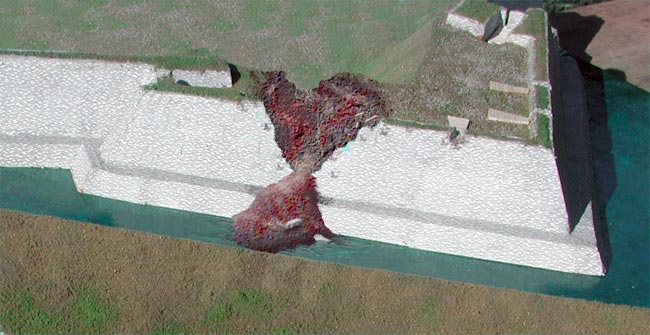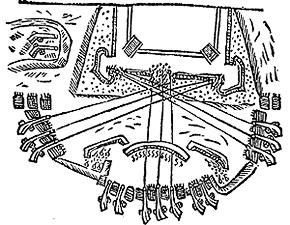 |
Hammering the Wall |
Breaching a defender's wall was usually a lengthy process of hurling one cannonball after another at the same spot. Compare to, say, you attempting to knock an opening in a ridge of heaped earth by poking at it with a the butt end of a broom handle, ramming it into the ridge, pulling it out and repeating. Imagine how much time and pokes that would require.

The wall of the bastion has been breached by prolonged cannon fire.
Seen here is the ideal situation for the attackers: the debris that tumbled down
from the breach has sufficiently filled the moat to create a causeway for them
to make the final assault. This did not always occur and attackers had to
resort to additional methods to cross that last barrier.
Once the battering of the walls began, only with very special diplomacy could the besieged avoid a sack. By this point, the attackers figured that plunder was owed them. The question at this stage was the fate of the garrison and even the civilians; if not slaughtered, would any or all be held for ransom. But even after the wall was breached, defenders sometimes sued for terms, hoping at least to preserve their lives - and attackers were receptive many times to a parley to save themselves the casualties of the final assault.
Round after round after round after round of heavy, solid cannonballs fired within a hundred meters of a wall eventually eroded it down, but at an enormous outlay of time, powder and cannonballs. In his 1567 The Bombardier's Examination, Girolamo Cataneo figured a single 30-pound half cannon delivered 110 shots a day, consuming 2,200 pounds of powder. Think what a dozen would go through. For comparison, in the 17th century, a single discharge of one heavy cannon costs as much as a pike - or approximately one month's wages for an infantryman (and powder was less expensive than a century earlier).
Thick earthen forts in the Lowlands absorbed artillery pounding so well that besiegers sometimes opted only to shoot out the cannon on top and the parapets, and then have infantry cross the ditch and clamber up a wall of the battered fort.
Besiegers fired their heavy cannon around the clock for days. In such bombardments, physical weaknesses of metals exhibited themselves in the nonstop heating and cooling of barrels, making for pulsing expansion and contraction of the metal, which led to metal fatigue - which led to muzzles breaking and flying off or, worse, a breech bursting and slaying all those nearby with shrapnel.
Besiegers had to have developed methods by which their artillery could be continually replenished with powder and ball in a reasonably safe manner. Often, there was a store of munitions for a battery several meters behind, usually in a hole with a trench running up to the battery.

Artillery continuously firing to breach the wall. Note the cannon
to the left and right firing diagonally at the embrasures behind the
orillons.
How many rounds were expended during a siege? In the English Civil War, 1645, Parliamentary forces hammered Pontefact with 1,400 rounds (from only three heavy cannon). 101 years earlier, the English discharged around 100,000 rounds of heavy shot in the 55-day siege of Boulogne (and ran out of powder). Steenwijk, 1592, 40 Dutch siege guns shot more than 6,000 solid rounds - in a single day. As many as 1,000 rounds were fired each day by attacking Imperial forces at the siege of Metz in 1552; 7,000 directed against a section of wall finally caused a portion of it to collapse but the forces of Charles V dared not assault the breech because defenders' cannons on the flanks could not be knocked out.
But there was an alternative to artillery for breaching a wall: destroying it from below.
| Back |
Going Under the Wall |
|
|
|
*John Muller, The Attac and Defense of Fortified Places, 2nd Ed, 1757